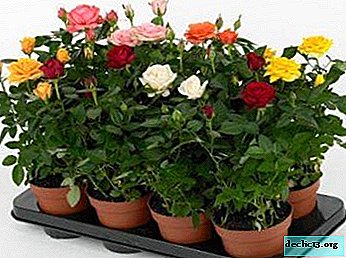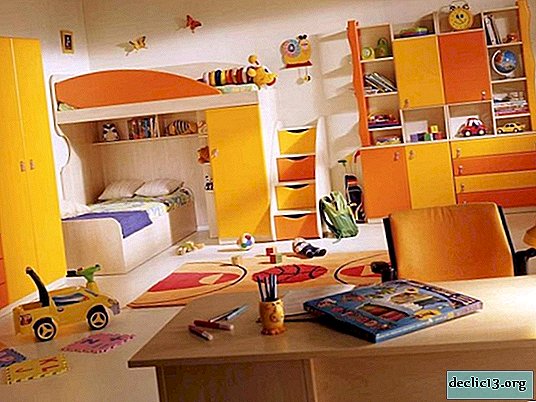Belvedere - impressive palace complex in Vienna
Belvedere Vienna, which is a huge palace and park complex, is one of the most interesting sights of the Austrian capital. From Italian, the word "belvedere" is translated as "beautiful view." And you know, this is completely true, because from the vast possessions of the palace, spread on the slopes of the mountain, a wonderful panorama opens up onto the streets of the Austrian capital and the Church of St. Stephen.

Complex structure
The Belvedere complex, which is often called the Austrian Versailles, consists of several parts, each of which has a unique atmosphere. We offer a virtual walk through the main historical monument of Vienna!
Lower castle Golden cabinet
Golden cabinetThe story of the Lower Belvedere might not have begun if not for the French Revolution, which forced the king and his relatives to seek safe refuge. It was then, in the distant 1714, the Generalissimo of the Holy Roman Empire, Eugene of Savoy, commissioned the architect Johann von Hildebrandt to build a new castle. The building turned out to be luxurious! The master bedroom is the Prince’s room, Mirror room, huge dining room, Golden cabinet, Marble gallery ... These places are still considered the main attractions of the Lower Palace. A few years later, the unique art collection of Emperor Joseph II was transferred here, which turned the Belvedere Museum in Vienna into one of the most visited corners of Austria.

Now in the halls of this castle there are several exhibits dedicated to the Baroque and the Middle Ages. In addition, temporary exhibitions of contemporary art are often housed here. But even if you are not interested in painting, you should come here at least to enjoy the original setting of the palace with its stucco bas-reliefs, wall paintings and frescoes by A. Martino, depicting the Prince of Savoy in the form of Apollo. The real pearl of the Lower castle is considered the Grotesque Hall, decorated in the ancient Roman style and decorated with allegorical sculptures with warped faces.

The Upper Belvedere in Vienna, whose construction was completed only in 1722, is the former representative residence of Prince Eugene of Savoy and one of the oldest museums on the planet. Visitors are impressed not only by the majestic facades of the castle, decorated with huge sculptures, but also by the permanent expositions of works by Austrian painters of the 19-20th century (Monet, Beckmann, Van Gogh, Renoir, Schiele, Kokoschka, etc.). The main highlight of this museum is the collection of paintings by Gustav Klimt, headed by the world-famous "Kiss". Experts argue that the total value of the collection of paintings in the Upper Belvedere in Vienna is estimated at billions of euros.

Due to the fact that it was here that balls and masquerades were held at one time, the central entrance to the palace passes through openwork forged gates, guarded by statues of lions with coats of arms on their paws and sculptures of cupids. The driveway, made in the form of a three-arch pavilion, is surrounded by dense green spaces, behind which you can hear the splash of a small lake. The stunning appearance of the building is complemented by a lush interior. But the most interesting is that it practically merges with the surrounding nature. In order to emphasize the proximity of Upper Belvedere to the surrounding landscape, the architect made a roof in the form of rounded multi-level tents resembling the surrounding hills.

It should also be noted that this part of the complex is associated with several historical episodes. So, in 1896, the famous composer and conductor A. Bruckner died in one of the rooms of the palace, and almost 60 years after this event, on May 15, 1955, an agreement was signed in the main hall, lined with red marble, which concluded the long German occupation and marked beginning of Austrian independence.
The parkThe cascade three-level park, which became the first alpine plantation in Europe, was founded in 1803 at the initiative of Archduke Johann. It is a symmetrical composition, made in the best traditions of old France and connecting the Upper Belvedere with the Lower. The author of this creation was the Bavarian architect Dominic Girard.

The main distinguishing feature of the Belvedere Park is the huge number of terraces, ponds, hedges, fountains operating from April to October, and decorative compositions decorated with sculptures of nymphs, newts, sphinxes and other mythical creatures. In addition, more than 4,000 alpine plants have been planted on its territory, creating an original pattern on lawns.

Nowadays this is a favorite vacation spot not only for visitors, but also for the crowns themselves. After a hard day's work, locals come here as whole families. Some have picnics on spacious green lawns, while others simply stroll through the park alleys, admiring the graceful architecture and wonderful landscape.
GreenhouseThe Belvedere Orangery in Vienna, located on the grounds of the Lower Palace, was a simple conservatory. In the winter, it was heated, and with the advent of summer, they removed the roof and the southern facade so that orange trees could enjoy the warm sunshine. At that time, the greenhouse of Prince Eugene was a masterpiece of carpentry, because, unlike other similar structures, it had a convenient sliding design.

Unfortunately, after the death of Generalissimo, orange trees were moved to Schönbrunn, and the building itself was converted for household purposes. The situation changed only in 1918, when the works of eminent Austrian modernists, expressionists and impressionists began to be exhibited here. So the former greenhouse turned into the Belvedere National Gallery in Vienna, attracting tourists from all over the world.
StablesThe stables of the castle deserve no less attention. Once upon a time, horses were kept in them, but now in the building is an exhibition of Kun Malvezzi, a famous German architect. The collection of this outstanding master totals more than 150 works - from late Gothic panels to the Roman crucifix. But its main asset is the altar, revealing the forms of the Renaissance. In addition, the former stables regularly hold training exhibitions on a particular subject of art and are closely related to the activities of the research center.
Research Center
The Belvedere Palace in Vienna is famous not only for its rich collection of canvases, but also for its unique research center, which studies and preserves outstanding works of Austrian art. The center’s fund stores a huge number of items created in various historical periods (from the 14th century to the present day). For a small fee, visitors can familiarize themselves with the collected collection, chat with the archive staff, get acquainted with the local library and view photographs from different Belvedere eras.Find out RATES or book any accommodation using this form
How to get there?
The Belvedere Palace in Vienna is located at Prinz Eugen-Straße 27, 1030 Vienna, Austria. There are two ways to get to it. Let's consider each of them.
Method 1 To the Lower Castle:

- Tram No. 71 - to Unteres Belvedere;
- Trams No. 2 and D - to Schwarzenbergplatz.
Method 2 To Upper Castle:
- Tram D - to Schloss Belvedere;
- Tram 18, O, 69A bus or local train - to Quartier Belvedere;
- From the Hauptbahnhof Underground Station on line U1 - walk no more than a quarter of an hour.
Working hours
Belvedere Castle in Vienna is open at certain times.

Upper castle:
- Mon-Thu, Sat-Sun - from 9.00 to 18.00;
- Fri - from 9.00 to 21.00.
Lower castle, greenhouse:
- Mon-Thu, Sat-Sun - from 9.00 to 18.00;
- Fri - from 10.00 to 21.00.
Palace Stables:
- Daily - from 10.00 to 12.00.
Research Center:
- Tue and Thurs. - 12.00 to 17.00;
- Wed and Fri - from 10.00 to 15.00.
Cost of visiting
Entrance to the palace complex is carried out according to several types of tickets.

| Ticket Name | Visitor age category | Price in Euro |
|---|---|---|
| Klimt ticket Applies to both locks, it saves at least 6 € (compared to standard adult rates). Valid for 30 days after the first visit. | Adults If you have a valid Vienna-Card | 22,00 19,00 |
| Elderly people (from 65 years old) | 19,00 | |
| Students (19-26 years old) | 19,00 | |
| Children and adolescents under 18 years of age (inclusive) | Is free | |
| Groups from 10 people | 20,00 | |
| Single ticket to Upper castle | Adults If you have a valid Vienna-Card | 16,00 13,50 |
| Elderly people (from 65 years old) | 13,50 | |
| Students (19-26 years old) | 13,50 | |
| Children and adolescents under 18 years of age (inclusive) | Is free | |
| Groups from 10 people | 13,50 | |
| Single ticket to Lower castle and greenhouse | Adults If you have a valid Vienna-Card | 14,00 7,00 |
| Elderly people (from 65 years old) | 11,00 | |
| Students (19-26 years old) | 11,00 | |
| Children and adolescents under 18 years of age (inclusive) | Is free | |
| Groups from 10 people | 11,00 |
Important! You can check the information on the official website of the castle: www.belvedere.at/en.
Useful Tips
When deciding to visit the Belvedere Castle in Vienna, take note of a few useful tips.

- The complex occupies a vast territory, so it’s better to leave extra things in the wardrobe (one for each castle). The cost of the service is only 50 cents. In return, they will give you a special receipt, which gives the right to free storage of clothes and souvenirs in the second dressing room.
- In order to relax, drink coffee and eat it is not at all necessary to leave the palace. You can eat in one of the local cafes and luxurious restaurants with an open gallery. By the way, it is from the terrace that the best photos come out.
- The castle is good at any time of the year, but spring and summer are considered the best time to visit it. The park is beautiful at this time!
- For travel by public transport, you should buy a daily pass. So you can visit not only the castle itself, but also other sights of Vienna (for example, Prater Park, Hundertwasser House or Schönbrunn).
- Those planning to visit the Palace Stables need to pre-register.
- Tickets are best bought online. In this case, they remain valid for six months from the date of acquisition. The date of the visit remains open. You can order no more than 30 pieces at a time.

Belvedere Vienna is a truly amazing place, the memory of which will surely remain in the heart of every tourist. Here everyone will find something for the soul. Art lovers - unique collections exhibited in museum halls, nature lovers - the freshness of fountains and the beauty of the Alpine flora, admirers of royal balls - rich palace halls, in which blue blood shone. The atmosphere of the castle will take you to amazing times from which you don’t want to return.

















